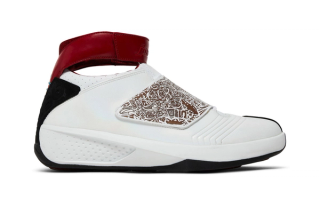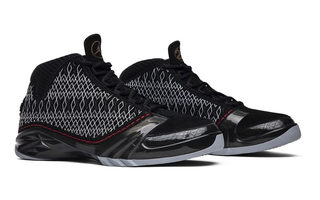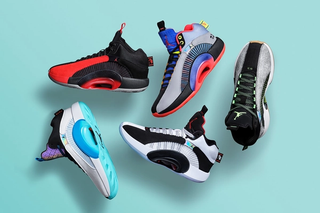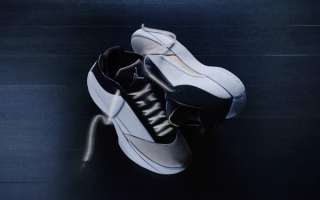Whether or not you celebrate them, birthdays are important. On a personal front, they solidify you’ve survived a whole 365 days (366 in a leap year) since the last one. In business, another year down signals prosperity, allowing for long-term plans to be ideated and executed.
Nike, Inc. might've not envisioned everything that would occur when it signed Michael Jordan in 1984, but it's since understood the importance of "His Airness" to its bottom line, sports, culture, and fashion.
The Air Jordan line launched in 1985, but didn't spawn into its own institution until Sept. 9, 1997 with the formal introduction of Jordan Brand. MJ's unprecedented stardom helped Nike proliferate its swoosh logo like never before while also making the brand synonymous with winning.
Although the Chicago Bulls legend is now retired from professional basketball, he continues to inspire hundreds of products, narratives, and initiatives on a yearly basis. The annual refresh to his signature sneaker line is always momentous, but more so when the model coincides with a fifth or 10th anniversary (e.g. 15th and 30th anniversaries of Air Jordan). (It's also important to note that some launches don't occur exactly on the milestone year, but they've been included in this retrospective because their order in the series coincides with every fifth or 10th model.)
With the recent launch of the Air Jordan 40, we decided to look back at every Air Jordan design to release on an anniversary year. Every silhouette has delivered the pinnacle expression of a performance basketball shoe while simultaneously telling His Airness' story and commemorating designs that have come before it.

Air Jordan 1
ORIGINAL RELEASE DATE: Sept. 16, 1985
Lead Designer: Peter Moore
It's only right to begin this trip down memory lane with the shoe that kicked things off: the Air Jordan 1.
While not specifically developed with Michael Jordan in mind, the silhouette helped the 22-year-old make a statement during his rookie NBA season.
Near-identical to the Nike Dunk High and now-Jordan Air Ship, the AJ1 served as the Swoosh's closest, readily-available answer to number 23's desire to play in an Adidas Top Ten-like design. The model proved useful throughout MJ's first two seasons while the Nike, Inc. team developed a signature sneaker from scratch by 1986.
Today, the Air Jordan 1 is one of the most popular shoes across the world. It's found homes amongst a variety of audiences and undergone numerous changes. Original "Bred" ("Black/Varsity Red") and "Chicago" ("White/Varsity Red") colorways remain the most iconic.

Air Jordan 5
ORIGINAL RELEASE DATE: Feb. 1, 1990
Lead Designer: Tinker Hatfield
Five years into the League, MJ had found his footing. Although he and his Chicago Bulls hadn't reached the NBA Finals by then, they continued to prove themselves against formidable, veteran-heavy squads.
The Air Jordan 5 was the third design by Tinker Hatfield for His Airness, and built on the performance and cultural success of its two immediate predecessors. On-court, the fighter jet-inspired design shone thanks to its reflective 3M™ material on the tongue. A co-sign from Will Smith while on The Fresh Prince of Bel-Air helped cement the fifth Air Jordan as a pop culture staple. The "Grape" pair worn on the sitcom has taken on a life of its own over the last 35 years.

Air Jordan 10
ORIGINAL RELEASE DATE: Nov. 1, 1994
Lead Designer: Tinker Hatfield
Michael Jordan won three consecutive NBA titles beginning in 1991 Playoffs.
On Oct. 6, 1993, he shocked the world by announcing his retirement from the League. Nike, Inc. decided to continue producing his signature sneaker line, launching the Air Jordan 10 in late 1994.
Spearheaded by Hatfield, the silhouette celebrated Mike's 10-year-spanning basketball career and many achievements. Stripes across the outsole list accomplishments like "85 Rookie of the Year" and "92 MVP / Championship." When His Airness decided to return to the NBA on March 19, 1995, he famously disliked his current Air Jordan model. That, however, didn't stop him from dropping 55 points against the New York Knicks at Madison Square Garden.
He did so wearing the number 45, a jersey number that's been linked to the design since.

Air Jordan 15
ORIGINAL RELEASE DATE: Holiday 1999
Lead Designer: Tinker Hatfield
Akin to the silhouette that arrived almost a decade before it, the Air Jordan 15 drew inspiration from a fighter jet—specifically the X-15.
Despite its robust build and top-of-the-line performance elements, Mike never wore the model for an NBA game as he had retired once more before its launch.
In recent years, netizens have argued about Hatfield's design, with some positing that it was before its time. Billie Eilish even applied a rather tonal "Stone" makeover to the shoe in 2021.

Air Jordan 20
ORIGINAL RELEASE DATE: Feb. 19, 2005
Lead Designers: Tinker Hatfield & Mark Smith
How do you celebrate two decades of greatness? Well, one way of doing so is by utilizing an all-new technology that enables design cues that were previously impossible.
Enter: The Air Jordan 20.
Spearheaded by Hatfield, the 20th anniversary Air Jordan saw Mark Smith bring state-of-the-art laser-etching to MJ's latest silhouette. The technology was used to decorate the lockdown strap running from medial to lateral side. Smith incorporated icons representing 200 memorable moments in Jordan's life onto the performance feature.
Elsewhere, silhouette departed from its immediate predecessor, boasting a segmented collar strap and porous midsole. The model has its fans, but it's been one of Jordan Brand's tougher sells.

Air Jordan 23
ORIGINAL RELEASE DATE: Feb. 16, 2008
Lead Designers: Tinker Hatfield & Mark Smith
Although Nike, Inc. had just celebrated a milestone anniversary for Jordan Brand three years earlier, the Swoosh conglomerate could not pass up on the opportunity to celebrate 23 years of Air Jordan in style.
Tinker Hatfield returned to the athlete-specific line with the Air Jordan 23, marking the importance of the occasion. Smith also joined, helping bring a desire to blend Michael Jordan's DNA into a shoe to life.
The segmented outsole featured traction patterns modeled after His Airness' thumbprint, which also appears on the tongue's underside. Other nods to the man behind the Jumpman include his signature on the toe and M and J letters stitched throughout the profiles. The design team set up to build the best Air Jordan possible and it did so in the AJ23.
The model's "Titanium" colorway launched at Nike's top 23 retailers for $230 in mid-February 2008. Only 23 pairs were made available at first in order to drive home the 23's significance.

Air Jordan 2010
ORIGINAL RELEASE DATE: Feb. 27, 2010
Lead Designers: Tinker Hatfield & Mark Smith
Following the release of Air Jordan's 23rd signature model, Team Jumpman decided to switch the line's naming structure. Each sneaker now included its respective launch year in the name, resulting in pairs like the Air Jordan 2010.
Now seven years into his final retirement, MJ was constantly on the lookout for exciting talent to champion the Jumpman on and off-the-court. One such face was Dwyane Wade, a then-one-time NBA champion from Chicago.
As the first Air Jordan design of the 2010s and the series' 25th overall, the AJ2010 prompted high expectations. Its peculiar TPU window at the mid-foot raised-eyebrows, but serious hoopers swore by the sneaker. Its successor wasn't too dissimilar, but abandoned the jarring "cut-out" on the sides.

Air Jordan 30
ORIGINAL RELEASE DATE: Feb. 10, 2016
Lead Designers: Tinker Hatfield & Mark Smith
By 2016, Michael Jordan had become larger than life. A whole new generation had become hip to some of his Air Jordan series' earliest designs. High-profile collaborations with some of the footwear and fashion industries' biggest movers and shakers helped the line reach unprecedented heights.
On the performance side of things, the Air Jordan 30 took what worked on its immediate predecessor and reimagined it through the lens of the cosmos. Why?: Because of the six-time NBA champ's "out of this world" talent.
Hatfield and Smith intentionally overlooked references to the past in an attempt to capture Jordan Brand's future on a shoe.

Air Jordan 35
ORIGINAL RELEASE DATE: Oct. 17, 2020
Lead Designer: Tate Kuerbis
Launched when the world was on pause, the Air Jordan 35 saw Team Jumpman rely on its growing roster of young talent to unveil the silhouette. Jayson Tatum, Zion Williamson, and Rui Hachimura all got their own editions of the model.
A nod to the Air Jordan 5 arrived via the tall tongue and 23 branding on the lateral heel of select styles, but tech-wise, Tate Kuerbis' design was more like the Air Jordan 34. A healthy mix of Bulls-friendly makeovers coupled with cutting-edge performance made the AJ35 a perfect blend of heritage and modern function.

Air Jordan 40
ORIGINAL RELEASE DATE: July 12, 2025
Lead Designer: Jason Mayden
Nike, Inc. had to pull out all the stops for Jordan Brand's 40th anniversary. Although much attention was spent on a painstakingly-faithful recreation of the Air Jordan 1 "Bred" from '85 during the first-half of the year, Jordan Brand kicked off the second-half with the release of the Air Jordan 40.
Visually, the design toned things down from the previous five silhouettes. Performance-wise, the AJ40 served the pinnacle expression of a basketball shoe. Its use of leather across the upper harkened back to what was expected of performance footwear years ago, while the combination of full-length ZoomX foam and full Zoom Strobel (a first) promised up to 85% energy return.
Jayson Mayden and company incorporated over a dozen different call outs to past Air Jordan designs in the AJ40.
The silhouette's release cycle has been staggered, but fans have expressed their desire for wider launches and more color schemes; some have even praised the model for being the first new Air Jordan in quite some time to be viable for fashion-use off-the-court.




